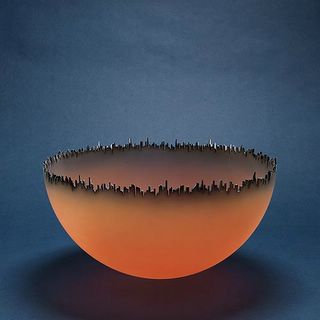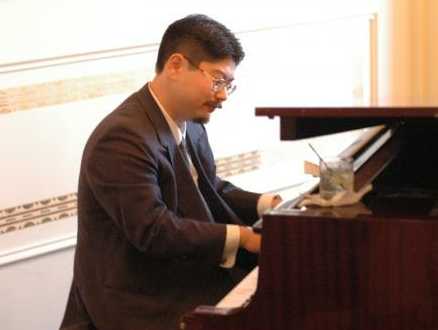22 Hours In: Corning, New York
On the recommendation of Dan and Daniel, on my trip back from New York to Canada, I did an overnight stopover in Corning, NY. As you can see from the map, it's a pretty reasonable midway stopping point. Dan explained to me that Corning is a 'company town' with a company that still makes money, so they put a lot of effort into their downtown, to keep it a non-embarassing place to visit.

One interesting thing on the drive: to get across most of New York State, I was on the highway NY-17, which was labelled "Future Interstate 86." I had never seen that designation before, and thought, "Oh, how cute, it's going to grow up to be an Interstate someday..." and "...when you adopt a highway, you never think that it might end up maturing into an Interstate..." or "After the larval state highway stage, the road then undergoes a metamorphosis period, covering itself in orange signs..." Anyway, here's the story behind it--it's just an extension of an existing Interstate; they are changing the intersections with traffic lights to overpass flyovers. Actually, it will do a nice job of straightening the path for this trip.
Caught dinner at a local brewpub (Market Street Brewing Company)--beer was acceptable, food was take-it-or-leave-it. Incidentally, while looking for their website, I found The Beer Traveller website--looks pretty useful for future reference (e.g. "I'm on the ground in West Virginia, and I really don't want to go to Thank Applebee It's Chili Bennigans for dinner.") The downtown section of Corning (Gaffer District/Market Street Historic District) was very pretty, but it was close to empty at 8 PM on a Tuesday night.

Cityscape, Jay Musler, 1984
Glass; blown, cut, sandblasted and airbrushed oil paint.
Anyway, on to the museum. The Corning Museum of Glass is pretty neat, in that it covers the art, history, craft, and science of glass. For instance, the museum has a huge collection of historic glass, from Egyptian times through today. The art is incredible--includes vases/glasses, cut leaded crystal, stained glass, and sculpture. I appreciate that they have exhibits explaining technique (e.g., all about 'cut glass')--perhaps this makes me all left-brain anal retentive, but I get a kick out of knowing how and why artistic techniques give the results that they do. For instance, I always wondered just how Rodin made his sculptures (clay -> lost wax or something?).
The science exhibitions were understandable without a huge technical background, but they didn't insult your intelligence in any way. I completely geeked out on their exhibits of borosilicate glass (i.e., Pyrex), fiber optic telecommunications, the mold for the Mount Palomar's 200" mirror, the development of float glass (i.e., creating flat glass by floating it on a layer of molten tin).
Another really cool exhibit was the process for making ultra-smooth glass for LCDs--you have to make a sheet of glass without touching either side (i.e., float glass won't work--too many imperfections where the glass contacts the tin). Therefore, if you follow the link, it's a technique where they create continuous sheets of glass in a manner so that neither face ever touches anything besides clean room air. Pretty slick.
Also, it did a great job of filling in various pieces of knowledge: Why did they ever decide to make 'lead crystal'? (increases index of refraction, and therefore 'sparkle' Just don't store your booze in it). Tiffany stained glass windows and lampshades were from the company created by Louis C. Tiffany--the son of Charles Tiffany, of the jewelery store.
I'm back home now in Canada. Driving back wasn't too fun: it was raining for most of the drive back, and it is difficult to tell white lines from shiny spots on the road with the glare of oncoming traffic and no streetlights. Wow... I guess driving wears you out: I woke up at 1 in the afternoon, after sleeping for 10 hours.


4 Comments:
Corning Glass Museum sounds way cool. As a bona-fide wannabe art geek, I *love* to learn the science behind the technique. Like leaded glass, you can make gold glass-- that's what the fresnel lens of Boston Light is made of. The edges (both planned and chipped) of the lens have a golden glow. It's an object designed for function, yet it's incredibly beautiful.
And thanks for your musings on the life cycle of the Interstate. Now I have to clean tea off my keyboard. Again.
Now I have to clean tea off my keyboard. Again.
Aww, thanks... that's the best feedback I get on my blog.
Also, another cool bit of trivia: the glass flowers at the Harvard Museum were made by a father son team, the Blaschkas. They actually got their start doing zoological models of sea creatures, such as anemones and sea slugs; they were on display at the Corning Museum. Glass slugs! Details here.
Glass Slugs?!?
Wow. Of course, that still couldn't replace Spot the Wonder Slug, who currently resides in the dining room (near the ponytail plant).
A disclaimer inn view of my recent holiday duck aquisitions (in case any of G's family stumbles upon this): No, I am not collecting slugs, nor do I need slug-themed tchochkes, earrings, or dishtowels. But thanks for the thought. :)
[That said, I did get a pretty cool duck with I'm guessing LEDs inside-- when you float it in the water, it puts on a little light show!]
When I checked out your blog and you only had the photo, not the entry, I was trying to decide where I had seen that piece of glass. My first instinct was CMOG, but then I realized you were in NYC, not Corning, so it must have been somewhere else. Who'd have thought I still have some long term memory left?
The Corning Museum of Glass rocks. When I went through on my bike tour, I think Jofish said he thought it was good for one or two hours. I spent three hours there and felt like I was leaving too early. It really helps to have some familiarity with the techniques. It makes guessing how some of the stuff must have been put together far more interesting. And I agree that the discussion of scientific glass was well balanced for nerds/kids.
You can check out my bike blog for my impressions.
Post a Comment
<< Home